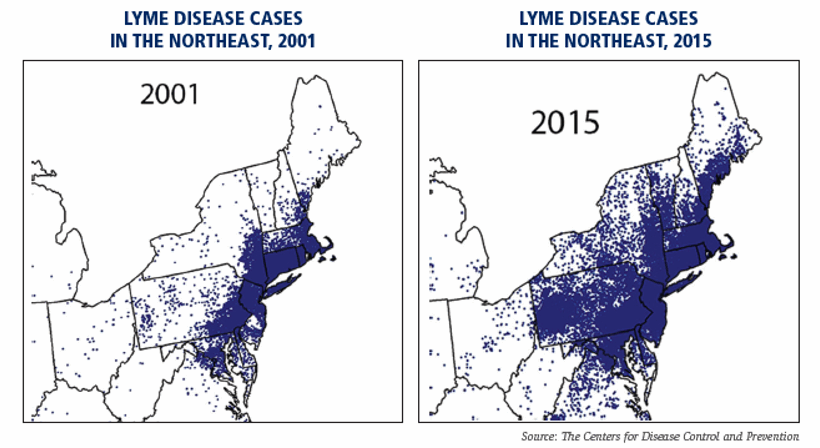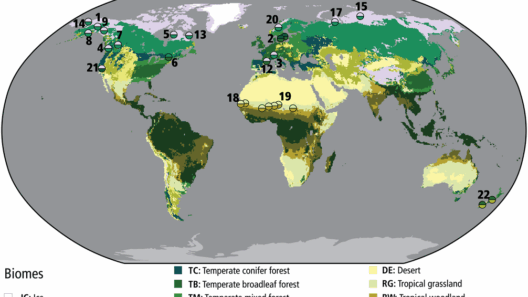As we traverse through the intricate web of climate change and its pervasive impacts, an intriguing question surfaces: does global warming facilitate an increase in Lyme disease prevalence? This inquiry holds significance far beyond mere scientific curiosity, as understanding the interplay between rising temperatures and tick-borne illnesses illuminates emerging public health challenges.
Lyme disease, predominantly caused by the bacterium Borrelia burgdorferi and transmitted through the bites of infected black-legged ticks, has seen a notable uptick in incidence over recent decades. The geographic distribution of ticks is intricately linked to climatic conditions, and with global temperatures on the rise, the current landscape of Lyme disease warrants close scrutiny.
At the crux of the matter lies the fundamental relationship between climate and vector-borne diseases. Ticks thrive in specific environmental conditions. Ideal temperatures and humidity levels can result in accelerated reproduction rates and enhanced survival rates of ticks. As the climate warms, particularly in temperate regions, ticks are emerging in areas previously inhospitable to them, effectively broadening their geographic range.
Consider the northern expansion of Lyme disease; historically confined to the eastern United States, Lyme disease has witnessed an alarming westward and northward shift. This phenomenon is emblematic of the far-reaching effects of climate change. As temperatures rise, it allows tick populations to flourish in zones that have traditionally been too cold, thus exposing new communities to the risk of infection.
Moreover, the life cycle of ticks is profoundly influenced by climatic conditions. Variations in temperature can alter the timing of tick development stages. Warmer winters may contribute to higher tick survival rates, enabling them to reproduce in larger numbers. Consequently, the potential for humans and other hosts to encounter infected ticks increases. As ticks advance through their life stages more rapidly, the window for human exposure expands, raising critical questions regarding public health preparedness.
The ecological ramifications of climate change are multifaceted. Habitats are transforming, species dynamics are shifting, and ecosystems are becoming increasingly intertwined. For instance, changes in forest composition—often influenced by temperature and precipitation shifts—can impact the abundance and distribution of both deer and rodents, which serve as primary hosts for ticks. More deer and rodents can lead to higher tick populations, and hence an escalated risk of Lyme disease transmission to humans.
In addition to the ecological and environmental aspects, human behaviors significantly contribute to the potential increase of Lyme disease incidence. As people modify their outdoor activities in response to climate change—such as hiking, camping, and spending more time in nature—inevitably, exposure to tick habitats increases. This escalating interaction enhances the likelihood of tick bites, elevating the risk of Lyme disease transmission.
The social and economic dimensions of Lyme disease also weave into this narrative. The burden of Lyme disease extends beyond physical health; it incorporates psychological and financial burdens for affected individuals and healthcare systems. As cases rise, health systems may become overwhelmed, necessitating urgent public health strategies and increased awareness campaigns to educate communities about prevention measures.
The emergence of antibiotic resistance adds another layer of complexity to the discussion. While antibiotic treatment is typically effective if administered early, the potential for complications increases if the disease is misdiagnosed or goes untreated, resulting in long-term health issues. The implications of climate change on the spread of Lyme disease, compounded by the threat of antibiotic resistance, thus pose a formidable challenge to public health.
As we ponder the paradox of progress in fields like healthcare and the unfortunate acceleration of vector-borne diseases, proactive measures must be prioritized. Research into climate impacts on infectious diseases is crucial, as is the development of comprehensive surveillance systems to monitor tick populations and Lyme disease cases. Early detection capabilities and robust public health strategies can mitigate risks, protecting vulnerable populations from devastating health outcomes.
Furthermore, community engagement is paramount. Education on tick prevention strategies, such as wearing protective clothing and using tick repellents, is essential. Encouraging communities to adopt preventative measures fosters collective responsibility, ensuring that individuals remain vigilant in recognizing the threat of Lyme disease as their environments evolve.
In summary, the intricate relationship between global warming and Lyme disease emphasizes an urgent need for interdisciplinary collaboration among environmental scientists, epidemiologists, medical professionals, and policy-makers. Addressing the challenges posed by Lyme disease amidst a changing climate requires a holistic approach to not only mitigate the impacts but also enhance public awareness and preparedness. With climate change acting as a catalyst for change, understanding and addressing Lyme disease is crucial to safeguarding public health in the face of an unpredictable future. How do we rise to the occasion, ensuring that we become proactive stewards of our health and environment rather than reactive victims of circumstances drastically altered by climate change?







